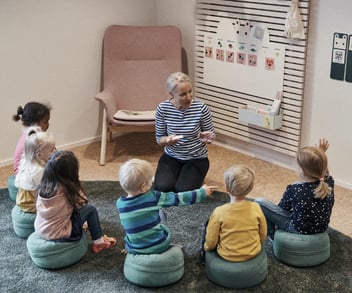How HEI Curriculum supports India's National Education Policy (NEP)

The National Education Policy (NEP) 2020 in India has laid out a forward-thinking plan to reshape the country's education system. At the core of this change is a commitment to holistic development, basic learning, and adaptability - principles that are embodied and visible in the educational philosophy of HEI Schools, rooted in the Finnish early education system. This blog post highlights 8 key objectives in India's National Educational Policy 2020 and shows how these goals are achieved with the HEI Curriculum.
Summary of the National Education Policy 2020:
India's National Education Policy (NEP) 2020 introduces significant reforms to revitalize both school and higher education.
- Replaces the traditional 10+2 structure with a more flexible 5+3+3+4 framework, focusing on holistic, multi-disciplinary, and activity-based learning for students aged 3-18.
- Emphasizes formative assessment - NEP restructures exams at various levels to foster critical thinking and conceptual clarity.
- Advocates for inclusive education, prioritizing equitable access for all students, including those from disadvantaged backgrounds and with disabilities.
- Requires trained teachers - requirements of a 4-year integrated B.Ed. degree by 2030, ensuring higher quality education delivery.
- In higher education, the policy aims to increase the Gross Enrolment Ratio to 50% by 2035, promoting multi-disciplinary and flexible curricula.
- Integration of technology - emphasis on integrating technology in education, supporting digital learning initiatives through the National Educational Technology Forum (NETF)
NEP’s goal for school education:
“Education Policy lays particular emphasis on the development of the creative potential of each individual. It is based on the principle that education must develop not only cognitive capacities - both the ‘foundational capacities ’of literacy and numeracy and ‘higher-order’ cognitive capacities, such as critical thinking and problem-solving – but also social, ethical, and emotional capacities and dispositions.” - Government of India, 2020
To achieve this, the new policy provides these fundamental principles set to guide India’s educational system at large and every individual institution in the system:
- Recognizing, identifying, and fostering the unique capabilities & promoting holistic development
- Achieve Foundational Literacy and Numeracy by Grade 3
- Flexibility & ability to choose learning programs based on learner's interest
- Multidisciplinarity & holistic education across the sciences, social sciences, arts, humanities, and sports
- Emphasis on conceptual understanding; staying away from rote learning & learn-for-exams learning
- Ethics and human & Constitutional values
- Extensive use of technology
- Full equity and inclusion
How HEI Schools approach & HEI Curriculum can support your preschool to achieve the NEP goals:
Let's have a closer look at each NEP's principles and dissect how the HEI Curriculum already incorporates these principles into its educational philosophy as well as our day-to-day teaching approach.
1. Recognizing, identifying, and fostering the unique capabilities & promote holistic development of each student
Both the NEP and HEI Schools place great emphasis on recognizing and nurturing the unique abilities of each child. The NEP promotes a holistic development model, prioritizing both academic and non-academic growth equally. HEI Schools approach promotes cognitive, emotional, and physical development through play- and inquiry-based learning methods. This shared focus ensures that education goes beyond mere information acquisition to cultivating well-rounded individuals.
Within the HEI Schools system, assessing a child involves evaluating not just cognitive aspects, but also their socio-emotional skills, such as their capacity for play. Play itself requires a diverse set of skills, including negotiation, communication, and creative thinking, making it a valuable lens through which to observe children's holistic abilities.
HEI Schools trained teachers are educated to observe each child across a variety of learning domains, from cognitive abilities to socio-emotional competence. This allows teachers to assess a child's holistic development. A follow-up tool is used to evaluate the development of each child. These assessments are regularly conducted to monitor their progress and growth.
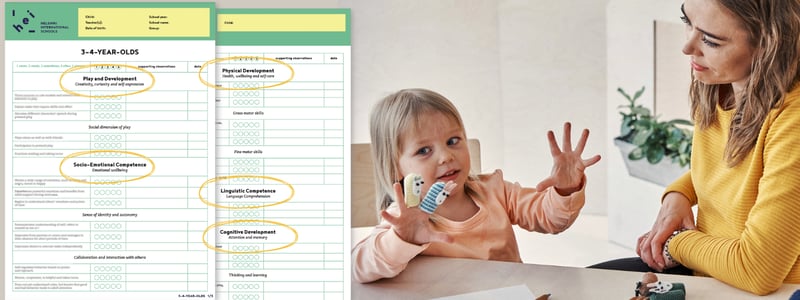
2. Achieve foundational literacy and numeracy by grade 3
The cornerstone of the NEP lies in prioritizing the attainment of fundamental literacy and numeracy by Grade 3. Similarly, HEI Schools underscore early development in these domains, employing interactive, hands-on approaches deeply rooted in the Finnish educational framework. Mastering academic skills can be effectively achieved through play-based learning techniques. While some may view play as mere recreation, research has proven the effectiveness of play-based teaching methods.
A study from the University of Cambridge analyzed decades of research on guided play, also known as play-based learning, concluding that it offers a beneficial middle path between free play and direct instruction. This form of learning not only nurtures children's enjoyment, motivation, and agency but also extends the scope for learning beyond what might be achieved independently. Key elements of play, including wonder, exploration, and child agency, when integrated into structured activities with teacher support. Teachers in play-based learning settings often have clear learning goals in mind, subtly guiding children toward these objectives without the need for strict control or specific output expectations.
The HEI Schools Curriculum features a Pre-Primary program, that integrates play-based and academic activities, aiming to equip children with more advanced mathematical, reading, and writing competencies, which often are required in many international schools in India. The math learning area covers topics like basic arithmetic up to 100, addition, subtraction, decimals, fractions, and coding. The linguistic program focuses on reading, writing, and English grammar skills.
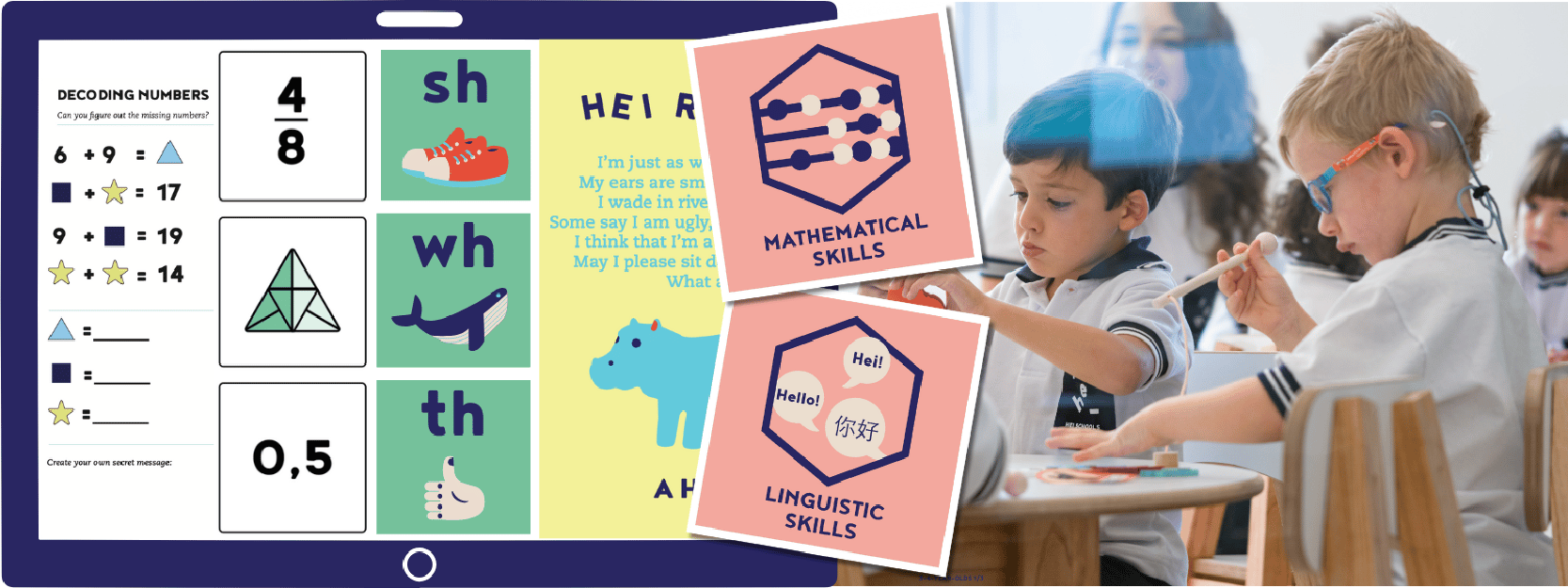
In the HEI Curriculum, academic concepts are introduced early on via play activities. These pre-mathematical and pre-linguistic skills include basic terms and concepts such as "more" and "less." Often, children can recite numbers from one to ten by heart, but they may not fully grasp the meaning behind the numbers. For example, why is ten more than eight? That's why we emphasize the importance of ensuring that each child has a basic understanding of these concepts to lay a strong foundation for continuous literacy & numeracy development.
 In the HEI Curriculum, the math and linguistic learning areas are intertwined in a multidisciplinary approach, rather than being kept separate. An example of this integrated approach is the activity called "Say It, Make It, Write It,". In this activity, children engage with basic addition and subtraction questions by vocalizing the equations (like "two plus two" or "2+2"), visually representing the equations with objects, and finally, writing down the answers to these math questions. These also offer enjoyable and interactive components that assist young children in staying focused and engaged. Watch a video about this activity here.
In the HEI Curriculum, the math and linguistic learning areas are intertwined in a multidisciplinary approach, rather than being kept separate. An example of this integrated approach is the activity called "Say It, Make It, Write It,". In this activity, children engage with basic addition and subtraction questions by vocalizing the equations (like "two plus two" or "2+2"), visually representing the equations with objects, and finally, writing down the answers to these math questions. These also offer enjoyable and interactive components that assist young children in staying focused and engaged. Watch a video about this activity here.
3. Flexibility & ability to choose learning programs based on learner's interest
India's Minister of Human Resource Development emphasized flexibility and freedom in choosing subjects as "students should design their own paths and life plans". The NEP's flexibility principle aligns with HEI Schools' child-centered approach, where we encourage exploration and discovery based on children's interests and strengths. Research proves that children's own interest in the topic makes learning more meaningful and hence more effective.
To foster interest, it's essential to expose children to a wide variety of topics, ensuring the material presented is novel, complex, and understandable. Making sure that children have sufficient background knowledge to find the material both interesting and comprehensible is crucial. This approach can start a virtuous cycle where increased knowledge leads to more questions, which in turn leads to more learning.
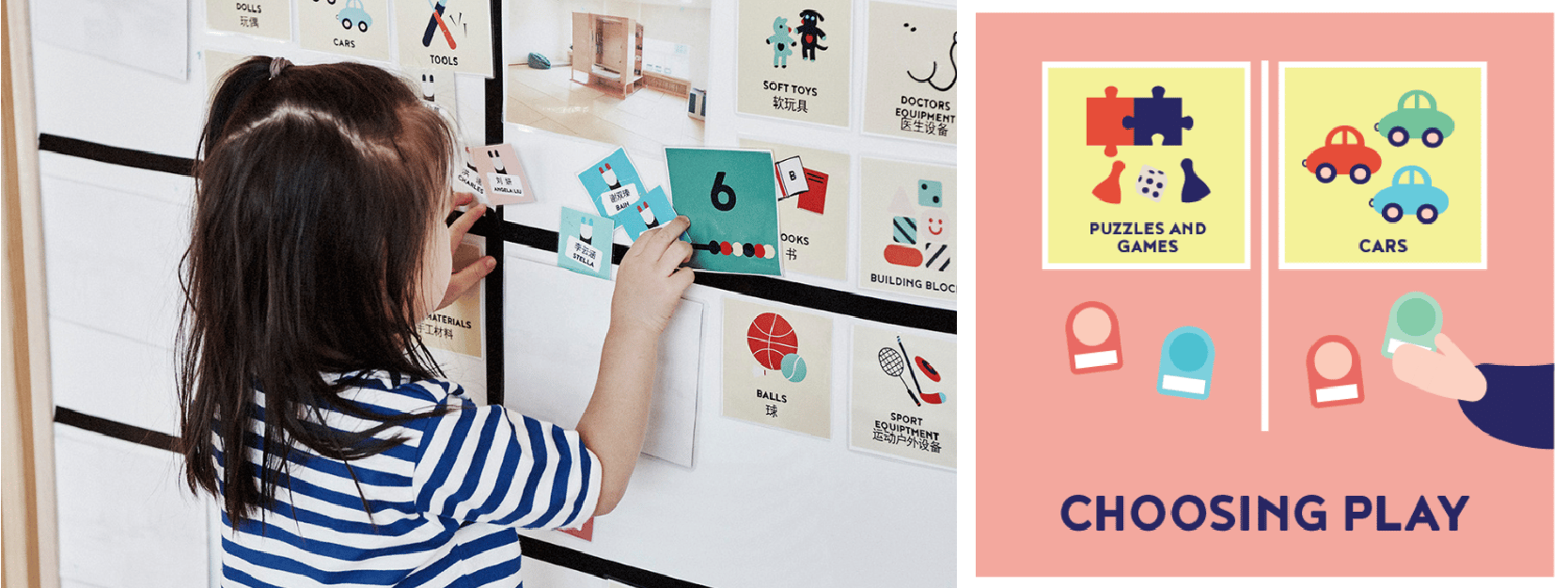
At HEI Schools, we not only support children in pursuing their interests through play but also cultivate their sense of agency and independence from a young age. In fact, each school year begins with a play chart board that aims to help children choose their interests and activities. The board and its pictograms will act as a visual aid to introduce them to the play options for that day. Children select the activities that appeal to them by placing their names on the chart. This daily process during the first month aims to cultivate a sense of independence and agency in children. Moreover, by seeing and interacting with the play chart, young children can enhance their understanding of the name, vocabulary, and visual representation of each play, especially for those who haven't played it firsthand.
4. Multi-disciplinarity & holistic education across the sciences, social sciences, arts, humanities, and sports
The goal of the Government of India with NEP is to achieve that "all students become good, successful, innovative, adaptable, and productive human beings in today's rapidly changing world." To achieve this, a curriculum should integrate learning across various disciplines.
As stated in the NEP, these disciplines include language proficiency, scientific thinking, creativity, aesthetics, and more. This reflects HEI Curriculum's natural approach of integrating multiple learning domains (such as STEAM with music and movement) to foster comprehensive perspectives in children's education.
Additionally, a report from the Brookings Institution underscores the importance of transforming education to support holistic student development. This entails focusing on the intellectual, physical, emotional, social, cultural, and moral development of students alongside academic learning. The report discusses initiatives in various countries that aim to make the whole child the center of their educational systems. These initiatives work within the constraints of academic rigor but strive to go beyond it to foster holistic development. The efforts in these education systems reveal that managing environments, (re)building educational infrastructures for holistic development, and integrating educational infrastructure with everyday practice in schools and classrooms are crucial. They offer lessons on engaging diverse stakeholders, constructing coherence, balancing common conventions with local discretion, and supporting the use of educational infrastructure in practice, among others.
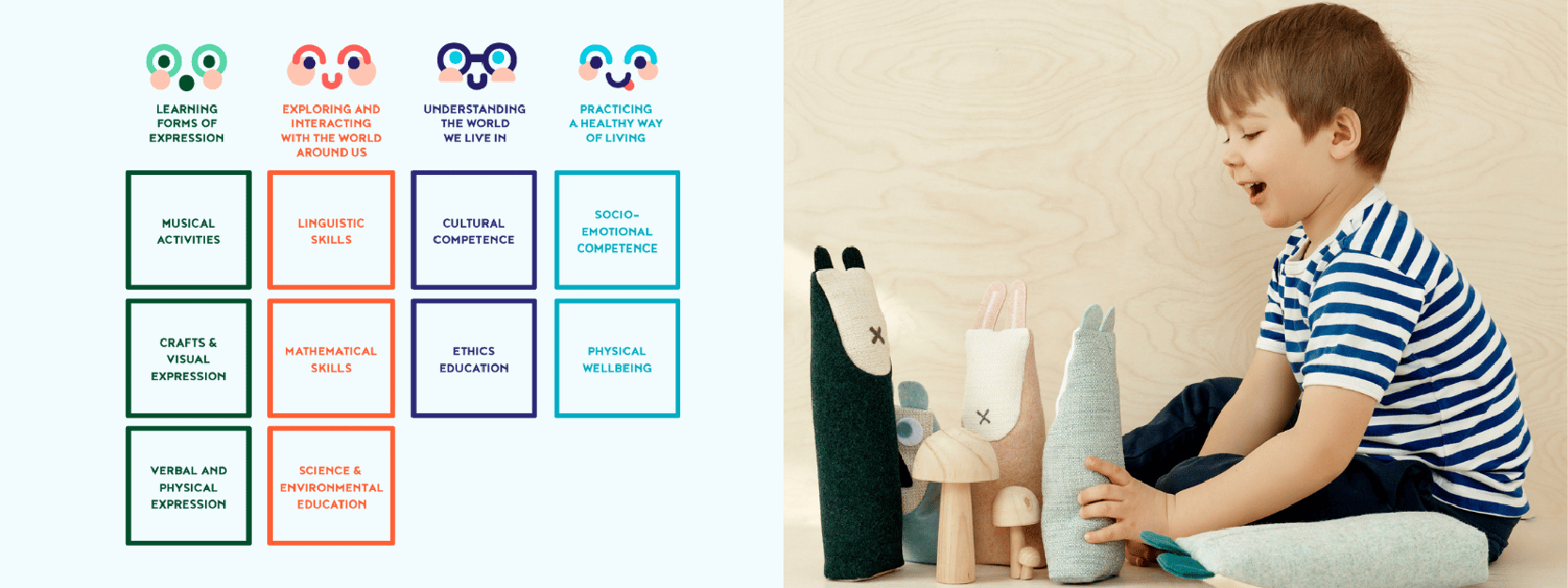 Holistic values and development are deeply embedded in the HEI Curriculum and framework. The HEI Curriculum has four important skills that we equip children for today's world: Forms of expression, Exploration and interaction with the world, Understanding our environment, and Promoting a healthy lifestyle. These skills are pursued through ten learning areas, which each have their own age-specific learning objectives.
Holistic values and development are deeply embedded in the HEI Curriculum and framework. The HEI Curriculum has four important skills that we equip children for today's world: Forms of expression, Exploration and interaction with the world, Understanding our environment, and Promoting a healthy lifestyle. These skills are pursued through ten learning areas, which each have their own age-specific learning objectives.
5. Emphasis on conceptual understanding; stay away from rote learning & learn-for-exams learning
Shifting the focus from rote learning to conceptual understanding is a key aspect of the NEP, a principle that is also fundamental in HEI Curriculum. Through project- and inquiry-based learning, children are encouraged to think critically, understand deeply, and apply their knowledge in various contexts, preparing them for the complexities of the real world.
For instance, a collaboration between researchers at Carnegie Mellon University and other institutions revealed that active learning strategies, which include interactive and engaging methods, are more effective than traditional lecture-based approaches. This research highlighted that methods encouraging students to actively produce thoughts and receive feedback lead to better learning outcomes. They noted the benefits of physical activity for creativity and idea generation and found that active learning approaches, contrary to students' beliefs, produce better outcomes than traditional lectures.
The HEI Curriculum & Pedagogy aims to promote the project-based learning approach. In fact, every month, children engage in projects aligned with the theme of the month. These projects demand various skills and foster a multidisciplinary learning experience. Take a look look at this project that focuses on machines and robotics for example:
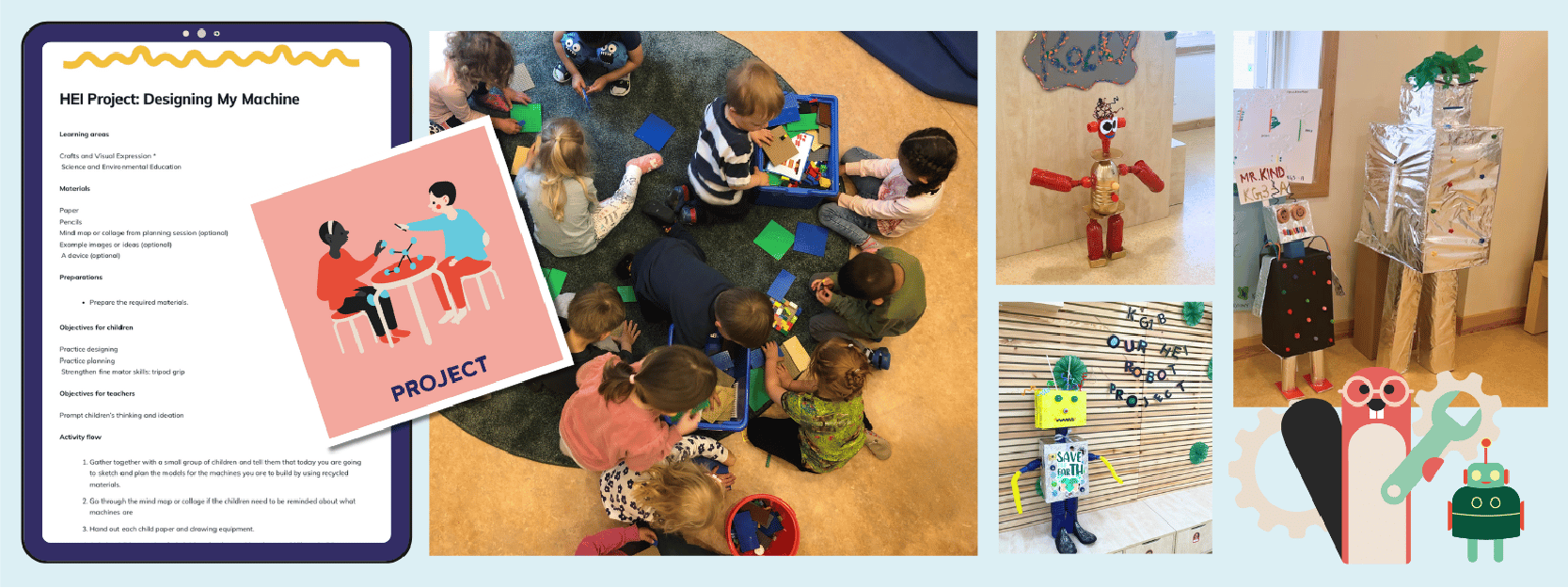
In this particular project, children are tasked with designing and constructing their own robots. The project isn't merely about assembling; it requires a range of skills. Children begin by creatively visualizing their robot designs on paper, then apply their math skills for precise measurements and construction. Their artistic flair and scientific understanding come into play as each robot becomes a unique creation. This engaging project immerses children in the world of robotics, enhancing their understanding of the technology that surrounds them.
6. Ethics and human & constitutional values
Both the NEP and HEI Schools curriculum emphasize the cultivation of ethical values and life skills. Respect, empathy, cooperation, and democratic spirit are not only taught but embedded in the daily experiences of children, reflecting a shared commitment to developing responsible global citizens.
Research highlights the significant benefits of ethics education for young children, particularly in developing social-emotional competencies and enhancing their understanding of others' emotions and perspectives, known as the Theory of Mind (ToM). The PEECh (Philosophical Ethics in Early Childhood) program, for instance, has shown positive results in preschoolers, including increased verbalization, use of justification in responses, emotion recognition, and perspective-taking. The expanded PEECh intervention aimed to further develop children's social-emotional competence and ToM, demonstrating that ethics education can play a crucial role in the holistic development of young children.
The HEI Curriculum engages children also in ethics education on a weekly or semi-weekly basis. These lessons are seamlessly integrated into a variety of planned activities, adding an element of fun, like the interactive puppet show on manners, or depth, such as discussions on diversity.
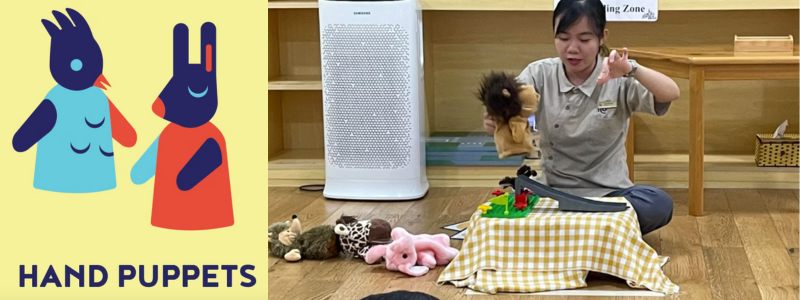
7. Extensive use of technology
Acknowledging the role of technology in modern education, the NEP advocates for its extensive use. At HEI Schools, we emphasize the importance of balance, ensuring that technology enhances rather than replaces traditional hands-on and cooperative learning experiences.
Research and expert insights highlight the significant value of incorporating technology and media into early childhood education, emphasizing developmentally appropriate practices and the potential for enhancing learning. For example, the National Association for the Education of Young Children (NAEYC) has discussed various ways early childhood educators can integrate technology and media into their practices, focusing on creating digital portfolios, fostering relationships with families, and supporting computational thinking and coding. This approach is underpinned by the intention to make technology use in education active, hands-on, engaging, and empowering for children, thus requiring a shift in perspective to see technology as a tool that supports developmentally appropriate practices.
Let's look at this activity that teaches children the use of cameras and media for example. Children are diving into the realms of news, advertising, media, and narratives - all crucial aspects of the 21st-century era:
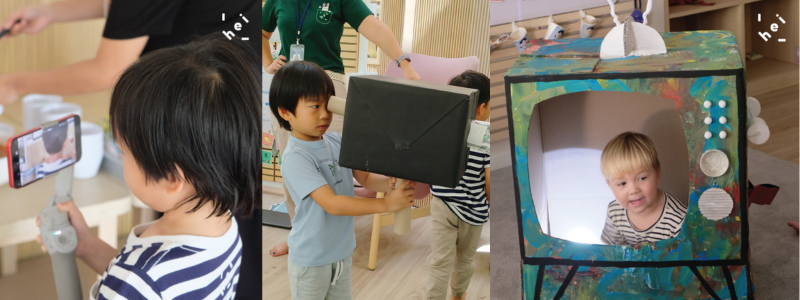
8. Full equity and inclusion
Inclusion and equity form the bedrock of the NEP's educational vision, ensuring that every child has the opportunity to succeed. The HEI Schools approach values individual learning paths and valuing each and every child’s individual strengths and providing support for their development areas.
The research underscores the importance of teaching young children about diversity, equity, and inclusion (DEI), highlighting the numerous benefits these lessons have on students' cognitive, social, and emotional development. Incorporating DEI into early education can lead to increased cultural understanding, stronger critical thinking skills, enhanced creativity, and better preparation for adulthood. The presence of diversity in the classroom encourages students to consider perspectives beyond their own, fostering creativity and promoting more effective problem-solving skills. Moreover, exposure to diversity from an early age prepares students for a diverse workforce and contributes to their development as engaged citizens.
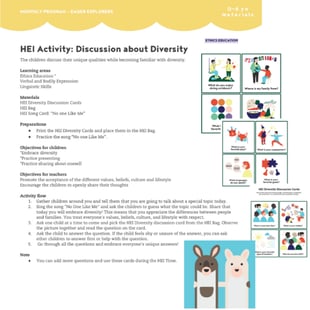 Incorporated within HEI Schools' curriculum, lessons on inclusion and equity are seamlessly integrated with ethics education in both weekly and monthly lesson plans. Discussions on diversity and inclusion are introduced early on, spanning across various age groups. HEI Schools trained teachers are also educated to appreciate each child's individuality and to guide children in valuing the differences and unique qualities of their peers equally.
Incorporated within HEI Schools' curriculum, lessons on inclusion and equity are seamlessly integrated with ethics education in both weekly and monthly lesson plans. Discussions on diversity and inclusion are introduced early on, spanning across various age groups. HEI Schools trained teachers are also educated to appreciate each child's individuality and to guide children in valuing the differences and unique qualities of their peers equally.
Conclusion
The National Education Policy of India and the HEI Schools Curriculum are well aligned and together, these educational frameworks signal a new era of learning that is holistic, flexible, integrated, and, above all, focused on the well-being and potential of every child.
By embracing these fundamental principles of the NEP and integrating the HEI Schools Curriculum, your preschool can take the lead in this nationwide transformation. You are the leader of your industry that transforms the education of every child under your care, equipping them with the necessary knowledge, skills, values, and mindsets to excel in a changing world!
Explore more with our educational solutions for you
So there you have it! An in-depth explanation of how the HEI Schools Curriculum can pave the way toward achieving the goals set forth by the NEP. But why stop at just reading? You can experience it for yourself.
We would like to invite you to take a look at our Toolkit Curriculum, which is one of our educational solutions that encompasses all the HEI Pedagogy & Teaching approaches mentioned above into one flexible and implementable curriculum. The Toolkit curriculum comprises all the lesson plans, activities, and additional resources that can be readily used by teachers at your school(s).
Sources
- Ministry of Education, Government of India. (2020). National Education Policy 2020. Retrieved from https://www.education.gov.in/sites/upload_files/mhrd/files/NEP_Final_English_0.pdf
- ClearIAS. (n.d.). National Education Policy 2020 – Highlights. Retrieved from https://www.clearias.com/national-education-policy-2020/
- Wikipedia contributors. (2020). National Education Policy 2020. In Wikipedia, The Free Encyclopedia. Retrieved from https://en.wikipedia.org/wiki/National_Education_Policy_2020#School_education
- Suh, J. et al. (2022). Effects of philosophical ethics in early childhood on preschool children's social–emotional competence and theory of mind. International Journal of Child Care and Education Policy. Retrieved from https://ijccep.springeropen.com/articles/10.1186/s40723-022-00098-w
- Kennedy, J., & Hupert, N. (2021). How to Use Digital Media to Support Preschoolers’ Learning. Edutopia. Retrieved from https://www.edutopia.org/article/using-digital-media-support-early-learning
- Datnow, A. et al. (2022). Transforming Education for Holistic Student Development. Brookings. Retrieved from https://www.brookings.edu/articles/transforming-education-for-holistic-student-development/
- Graue, M. E. (2016). The Power of Play-Based Learning. Edutopia. Retrieved from https://www.edutopia.org/article/young-kids-power-play-based-learning
- Song, A. et al. (2021). Title of the referenced article. Child Development. Retrieved from https://srcd.onlinelibrary.wiley.com/doi/10.1111/cdev.13730
- Carnegie Mellon University. (2021). Active Learning Boosts Student Outcomes. Retrieved from https://www.cmu.edu/news/stories/archives/2021/october/active-learning.html
- Paul, A. M. (2013). How the Power of Interest Drives Learning. KQED MindShift. Retrieved from https://www.kqed.org/mindshift/32503/how-the-power-of-interest-drives-learning
- Moses, A. (2023). Technology and Media in Early Childhood Education. NAEYC. Retrieved from https://www.naeyc.org/resources/pubs/yc/winter2023/technology-and-media-early-childhood-education
- Spiegler, J. (2016). Teaching Young Children About Bias, Diversity, and Social Justice. Edutopia. Retrieved from https://www.edutopia.org/blog/teaching-young-children-social-justice-jinnie-spiegler
- American University School of Education Online. (2019). The Benefits of Inclusion and Diversity in the Classroom. Retrieved from https://soeonline.american.edu/blog/benefits-of-inclusion-and-diversity-in-the-classroom/



